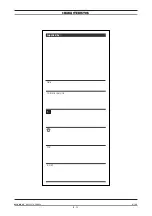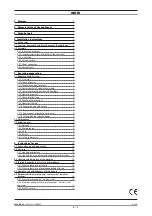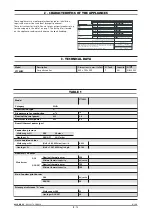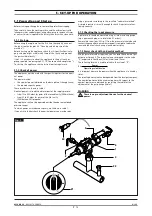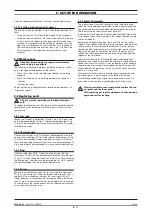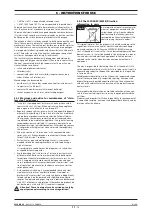
6 - INSTRUCTIONS FOR USE
• 1.4016 or 1.4511 = magnetizable chromed steels
• 1.4301, 1.4401 and 1.4571 = non-magnetizable chromed steels
Chromed steels have favourable thermo-technical characteristics. In
fact, they have less of a tendency to warp due to the effect of heat.
Chrome-nickel steels, instead, have good corrosion resistance features.
“Stainless steel” corrosion resistance is given by an inactive coat that
builds up on the surface by coming into contact with oxygen.
The oxygen in the air is already enough to build up the inactive coat
that allows automatic removal of anomalies and damage due to
mechanical actions. The inactive coat builds up or re-builds up faster
if the steel comes in contact with running water containing oxygen.
A more powerful effect is given by oxidative acids (nitric acid, oxalic
acid). These acids are used if the steel has undergone strong chemi-
cal stresses, hence generally losing its inactive coat.
The inactive layer can be chemically damaged or jeopardized by
reducing agents (oxygen consumption) if they come in contact with
the steel, concentrated or at high temperatures. These active sub-
stances include for instance:
• saline and sulphurous substances
• chlorides (salts)
• concentrated spices such as mustard, vinegar essences, soup
cubes, kitchen salt solutions, etc.
More damage can be caused by:
• outside rust (i.e. from other components, tools or incipient rust)
• iron particles (i.e. file dust)
• contact with non-ferrous metals (element build up)
• lack of oxygen (i.e. no air inlet, water lacking oxygen).
6.6.2 Warnings and advice for maintenance of “stain-
less steel” appliances
• “Stainless” steel equipment surfaces must be kept clean and in
contact with air at all times. When not running, keep appliance
doors open so as to allow air to run through it.
• Regularly remove calcium , grease, starch, and egg white deposits
where rust may build up if there is lack of air. Do not use bleach-
ing products or products containing chloride. Follow all indica-
tions given by the company concerning special soaps and clean-
ing methods to be used for the appliance. If no specific cleaning
recommendations are available, it is necessary, however, to use
detergents having a low chloride content. After cleaning, remove
all soap residues with plenty of clean water and thoroughly dry
the surfaces.
• Minimize contact of “stainless steel” with concentrated acids,
spices, salts, etc. Even acid vapours coming from cleaning the tiles
favour “stainless steel” corrosion.
• Particularly for pots and multiple appliances, it is not recom-
mended to load the cooking chamber only with food having a
high salt content.
It is preferable to cook different food together, i.e. fatty dishes
or vegetables containing acids.
• Avoid damaging the “stainless steel” surface, in particular with
different metals. Residues from other metals help build up the
formation of chemical microelements that may cause rust. At any
rate, it is appropriate to avoid contact between iron and steel
since it produces rust. Any contact between “stainless steel” and
iron (steel wool, pipeline chips, chalybeate waters) can start cor-
rosion phenomena.
• As for mechanical cleaning, it is recommended to use only steel
wool or natural, plastic or steel bristle brushes. Steel wool or
brushes with “stainless steel” can cause rust due to rubbing. Newly
formed rust spots can be removed with slightly abrasive liquid
soaps or fine-grained sand paper. Larger rust spots can be removed
with 2-3% of hot oxalic acid solution. If these cleaning products do
not do the job, a nitric acid (10%) treatment is required.
Attention! These treatments can be carried out only by
expert personnel according to current regulations!
11
· 12
6.6.3 The 2002/96/EC (WEEE) Directive:
information to users
This informational note is meant only for
owners of equipment marked with the
symbol shown in fig. A on the adhesive
label featuring the technical specifica-
tions applied on the actual product (the
label also giving the serial number).
This symbol indicates that the product is classified, according to the
regulations in force, as an item of electrical and electronic equip-
ment and conforms to EU Directive 2002/96/EC (WEEE) meaning
that, at the end of its service life, it must be treated separately from
domestic waste, i.e. it must be handed in free of charge to a separa-
te waste electrical and electronic equipment collection centre or
returned to the reseller when buying a new equivalent item of
equipment.
The user is responsible for delivering the unit at the end of its life
to the appropriate collection facilities. Failure to do so shall result in
the user being subject to the penalties prescribed by the legislation
in force on waste.
Suitable separated collection so that the unit no longer used can be
sent off for environmentally compatible recycling, treatment and
disposal helps avoid possible negative effects on the environment
and on health and facilitates the recycling of the product's compo-
nent materials.
For more detailed information on available collection systems, con-
tact the local waste disposal service or the shop you purchased the
unit from.
Producers and importers fulfil their responsibility for environmental-
ly compatible recycling, treatment and disposal both directly and by
joining a collective scheme.
Fig. A
0820_GB_99
- GAS PASTA COOKER
01/2016


